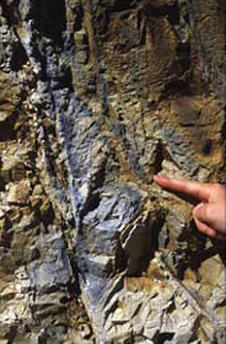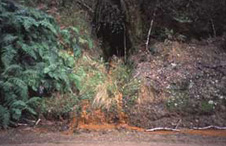Acid generation
 Acid producing rock, Coromandel. The grey patches are rich in pyrite, and rain water running off this outcrop has pH near 2.
Acid producing rock, Coromandel. The grey patches are rich in pyrite, and rain water running off this outcrop has pH near 2.
- Iron sulphide minerals, pyrite and marcasite (FeS2), readily decompose in oxygenated waters at the surface.
- One of the products of this decomposition reaction is sulphuric acid.
- This acid lowers the pH of the immediate environment, and can spread downstream (= "acid rock drainage")
- Environmental pH <1 is possible in this situation.
Acid neutralisation
- The acidification can be limited if the surrounding rocks contain reactive minerals, especially calcite (calcium carbonate).
- There is sufficient calcite in schist to neutralise acid from pyrite in schist-hosted gold deposits, which almost invariably yields environmental pH between 6 and 8.
- There is insufficient calcite in most volcanic rock related gold deposits to neutralise acid from pyrite oxidation, and acid rock drainage is common.
Metal mobility
 Neutral pH water seeping from a historic gold mine, Reefton, has elevated arsenic and antimony. Arsenic and antimony are also adsorbed by the brown iron-rich precipitate.
Neutral pH water seeping from a historic gold mine, Reefton, has elevated arsenic and antimony. Arsenic and antimony are also adsorbed by the brown iron-rich precipitate.
- Low pH encourages environmental mobility of cadmium, copper, lead, and zinc in streams and groundwater.
- Very low pH (<2) facilitates mobility of aluminium, iron and manganese in streams and groundwater.
- Arsenic and antimony are more soluble at neutral pH than at low pH.
- Hence, volcanic-related gold deposits typically yield acid waters with elevated Cd, Cu, Pb and Zn, with some As.
- Schist-hosted gold deposits can yield waters with very high As and Sb.
Related
Introduction
Overview: Geological setting for Metals in the New Zealand environment
- Epithermal Gold
- Mesothermal Gold
- Acid Rock drainage
- Coal
- Metals in groundwater
- Alluvial Gold
- Northland Mercury
-
Hot Springs (in heavy metals)